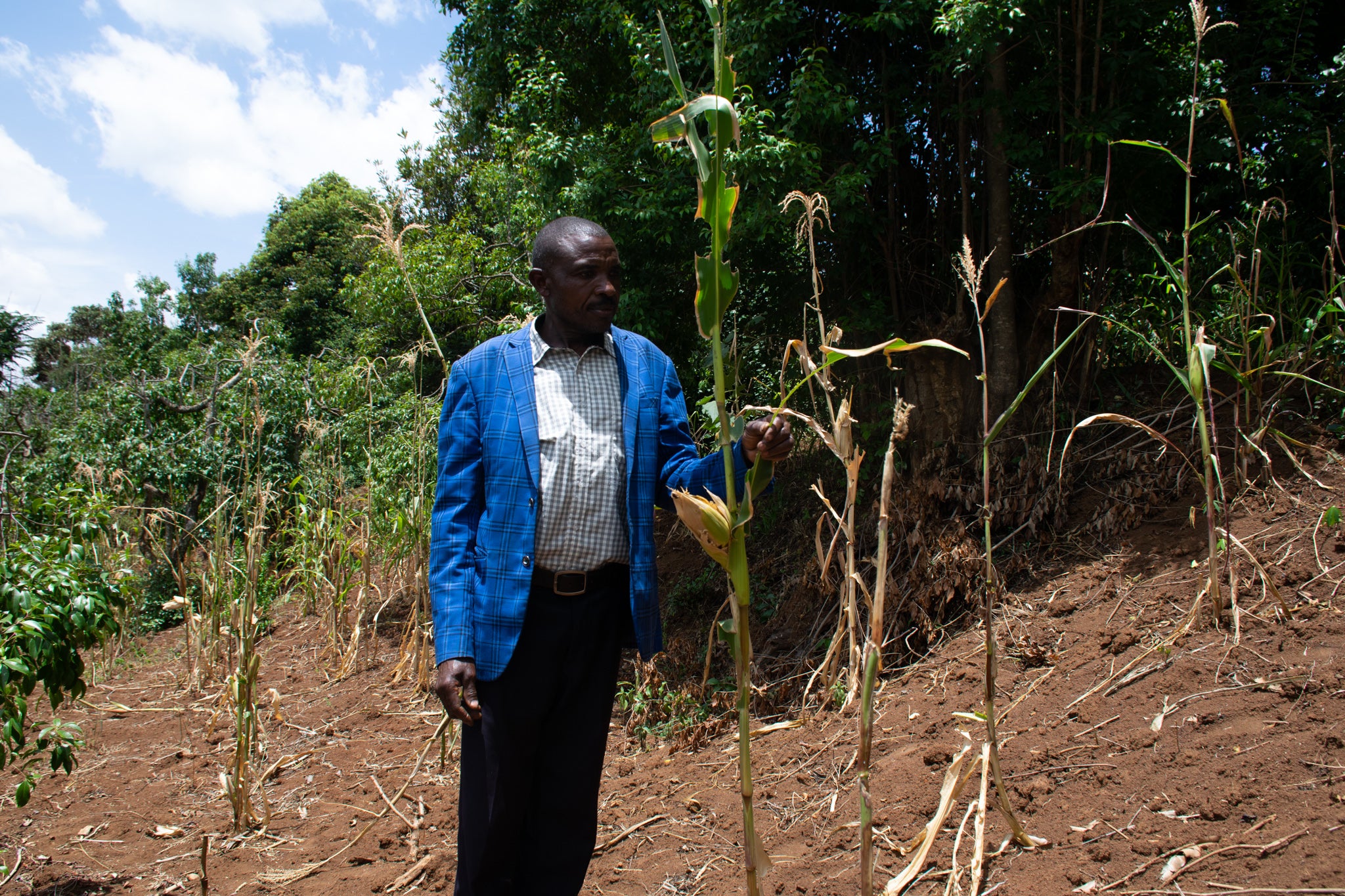How Kenya’s farmers are trying to outsmart locusts and climate change
As the risk of food insecurity rises, farmers in East Africa are having to adapt to ensure crops grow, reports Federica Marsi in Meru, Kenya

James Laboni had never seen anything like it in his lifetime. First came the screams, then the loud banging of pots and pans.
He ran breathlessly towards the maize fields, covering the short distance in just a few minutes. From a vantage point overlooking his property, the scale of the devastation was glaring.
“The work of three months was gone in a matter of seconds,” the 49-year-old farmer tells The Independent.
A small swarm of desert locusts can consume the same amount of food in one day as 35,000 people. They strip a plant of its leaves, chewing of the node below the head and causing it to drop off.
Laboni’s 1.5 hectares of land in Mbaranga, in Kenya’s lush eastern province of Meru, had been enough to provide for his six school-aged children and two elderly relatives. The day the locust came, on a warm February afternoon, he worried for the first time about how to scrape together the next meal.
Desert locusts first infested the Eastern Horn of Africa in mid-2019, eventually invading nine countries. The first swarms arrived in Kenya in late December, moving quickly throughout the country’s northern and central areas.
By January 2020, the country was experiencing its worst infestation in 70 years. Experts say the worst outbreaks may be yet to come.
“Our latest updates shows that the locusts are moving towards more crop areas, so the scale of destruction in Kenya and northern Tanzania might be even greater compared to last year,” Kenneth Kemucie Mwangi, satellite data analyst at ICPAC, a climate monitoring body focused on East Africa, tells The Independent.
In order to set up a coordinated response, all locust-affected countries transmit locust data to monitoring agencies including the Food Agriculture Organisation (FAO), who analyse this information through satellite imagery and provide forecasts and early warnings.
Erratic weather patterns, aggravated by a prolonged bout of exceptionally wet weather, provide the ideal climatic conditions for the formation of new swarms. Traditionally, the only effective method to control extreme locust infestations has been through chemical pesticides.
Yet, spraying planes might not be enough to contain the outbreak.
“Based on how much the swarms are still increasing and migrating southwards, pest control is clearly not as effective as we would want it to be,” says Kemucie Mwangi. Locusts are a compounding threat on economies already hit hard by the spread of Covid-19.

In Meru, a stronghold for the cultivation and export of a stimulant leaf known as miraa or khat, flight bans and border closures following the spread of the pandemic have caused the price of the red-stemmed, chewable shrub to tank.
The pain was felt the most by farmers like Angelica Mukomunene, 37, whose household had relied on mira to pay for food and school fees for her five children.
“We used to make 70,000 Kenyan shillings [£459] a month, now we’re lucky if we get 20,000,” Mukomunene tells The Independent.
FAO and ICPAC have warned that food insecurity is on the rise. Over 13 million people in Djibouti, Eritrea, Ethiopia, Kenya, and Somalia are currently experiencing “severe acute food insecurity,” while another 20 million are on the brink.
Given the bleak forecasts, farmers have set out to outsmart the pests. Planting winter pulse and oilseed crops that are less palatable to the voracious locusts is one possible solution.
Bright yellow sunflowers now grow on patches of land where Mukomunene used to cultivate maize and miraa. Ten bags of sunflower seeds yield a monthly 21,000 KSh [£138], a far cry from the pre-pandemic profitability of miraa.
But sunflower is relatively risk-free compared to other crops and farmers crave security. An alternative source of income for cattle owners is scaling up dairy production from subsistence farming to commercial production.
“There is an increasing demand of milk coming from the growing urban population, but our milk production has not increased in parallel,” says Julius M’Itonga, director of livestock production in Meru County.
Long stifled by high entry production costs and lack of technical know-how, Meru’s dairy industry has now been injected with new life. The Italy-based Association of Volunteers in International Service (AVSI) and other non-governmental organisations have provided training to dairy cooperatives, equipping them with the cooling systems and pre-sterilised containers.
A number of obstacles still prevent dairy farming from being profitable. On average, farmers in Meru produce nine litres per cow, well below the 12 litres they need to break even.
The loss of maize crops to the locust swarms also forced farmers to spend almost a third of their returns on buying cattle feed, which is often of poor quality.
“On the label a bag of concentrate feed is said to contain a certain percentage of proteins, but our tests have shown it is less than indicated. It means our farmers get less milk production because they are being cheated,” says M’Itonga.
Locusts are at the root at this problem, but they are also becoming part of the solution. The Bug Picture, an agricultural start-up that looks to contribute to solutions around environmental challenges using insects, is pioneering ways to use locusts as a protein supplement in animal feed.
![Angelica Mukomunene: ‘We used to make 70,000 Kenyan shillings [£459] a month, now we’re lucky if we get 20,000’](https://static.independent.co.uk/2021/03/06/10/Angelica%20Mukomunene.jpg)
“One of our primary goals is to create a locally produced, consistent-quality protein source,” Laura Stanford, the company’s founder and CEO, tells The Independent.
“The animal feed market in Kenya is very much slanted towards the feed miller and not towards the farmer. We want to push for an affordable alternative.”
The company is currently buying locusts from farmers who use boda bodas, or motorcycles, to hunt down the swarms and then catch them using wide nets.
The insects are then harvested in bags for four days as a precautionary measure. If any of them die, it is a telling sign that they were sprayed with pesticide and cannot be used as feed for livestock.
Compared to a vegetable-base protein like soy, preliminary lab tests have shown locusts to contain higher nutrition values.
The company is now working with academic institutions to validate these results and scale up community-based harvesting and processing of locusts.
“In an ideal world, everything has value,” says Stanford. Under this premise, a biblical plague may turn out to have a silver lining.



Join our commenting forum
Join thought-provoking conversations, follow other Independent readers and see their replies
Comments